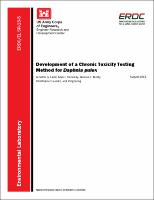Please use this identifier to cite or link to this item:
https://hdl.handle.net/11681/3314| Title: | Development of a chronic toxicity testing method for Daphnia pulex |
| Authors: | Badger Technical Services Army Environmental Quality Technology Program (U.S.) Laird, Jennifer G. Kennedy, Alan James, 1976- Melby, Nicolas L. Lounds, Christopher D. Gong, Ping |
| Keywords: | Chronic toxicity testing method Cladoceran Contaminant of Concern Daphnia pulex Organism loading procedure Toxicogenomics Toxicological endpoint data Toxicity Testing methods Procedures |
| Publisher: | Environmental Laboratory (U.S.) Engineer Research and Development Center (U.S.) |
| Series/Report no.: | ERDC/EL SR ; 15-5. |
| Description: | Special Report Abstract: Acquiring reliable toxicological data about cladocerans is important for gauging any environmental contaminant of concern. Acute and chronic bioassay methods for the testing of cladocerans (water fleas) were developed by the American Society for Testing and Materials (ASTM), United States Environmental Protection Agency (USEPA), Organisation for Economic Cooperation and Development (OECD), and International Organization for Standardization (ISO) and have been extensively employed to determine the hazard of many substances. These organizations currently do not provide a standard chronic toxicity test method for assessing environmental contaminants to the cladoceran Daphnia pulex. This organism is important for toxicological testing as it is very sensitive to contaminants and has a well-sequenced genome for toxicogenomics investigations. Since a chronic D. pulex method was required to execute research conducted at the U.S. Army Engineer Research and Development Center’s (ERDC) Environmental Laboratory, modifications were made to the current USEPA (2002) chronic method for Ceriodaphnia dubia and the ASTM (2012) and OECD (2008) chronic methods for Daphnia magna. The protocol described in this technical report provides a step-by-step chronic toxicity method specifically for Daphnia pulex, with the following adaptations: (1) modifications to the exposure chambers and water exchange apparatus and methods; (2) modifications to the organism loading procedure; and (3) modifications to the test duration to accommodate 3-broods. The protocol yields reproducible toxicological endpoint data. |
| Rights: | Approved for public release; distribution is unlimited. |
| URI: | http://hdl.handle.net/11681/3314 |
| Appears in Collections: | Special Report |
Files in This Item:
| File | Description | Size | Format | |
|---|---|---|---|---|
| ERDC-EL-SR-15-5.pdf | 1.44 MB | Adobe PDF |  View/Open |